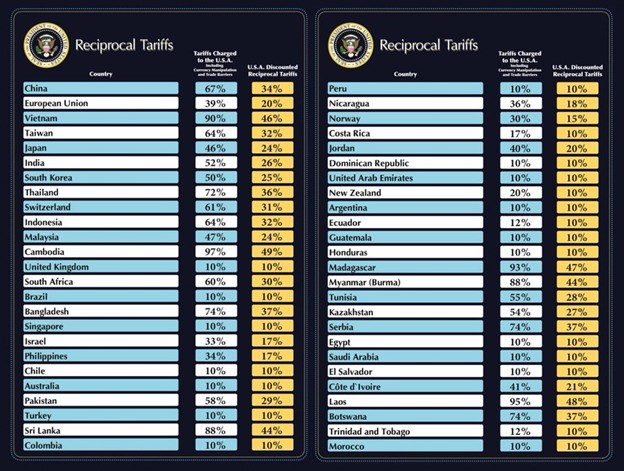What imports specifically are subject to tariffs?
President Trump announced a new set of reciprocal tariffs at market close on April 2nd, delivering on a campaign promise. The announcement included a 10% tariff on all imports, with higher tariffs for certain countries. Regions and countries that will be subject to higher tariffs include: China (34% tariff), Taiwan (32%), Japan (24%) and Europe (20%). A full list of the affected countries is provided in Exhibit 1. These targeted tariffs are based on a calculation that aggregates a country’s total tariffs and non-monetary trade barriers, with the U.S. imposing a rate equal to roughly half that amount. The 10% tariffs are expected to go into effect on April 5th, with the higher tariffs kicking in on April 9th.
Initial stock reaction is negative with all indices dropping sharply in after-hours trading. The measures appear significantly more aggressive than markets had anticipated, with the 10% blanket tariff along with higher tariffs for several big trading partners most likely being a surprise to many.

How is this going to impact the U.S. economy and the market?
The introduction of a blanket tariff on all goods and steep tariffs on certain countries will likely cause further doubt on the disinflation trend. Last week on Friday, Core PCE inflation numbers for February came in at 2.8% year-over-year (YoY), still far above the Fed’s 2% target – and this was before any major tariffs were enacted. Tariffs are also likely to put strain on the consumer through an increase in prices – most notably the lower-income consumer given that they spend a large share of their income on goods and have smaller savings buffers to weather the hit to real incomes. Near-term, this is likely going to impact certain sectors and companies more than others. Sectors and industries that are most exposed include autos, consumer discretionary (most notably clothing, personal care products, household appliances, and recreational goods), electronics and electrical equipment, and construction and materials. These industries are some of the most exposed in that they import a significant amount of inputs, with some of them having a low degree of pricing power as well. Companies that have high exposure to low-income consumers are also at risk – given that as stated previously they spend more of their income on goods and are more price sensitive. Companies that are able to pass on more of the price increase to consumers should be less likely to see margins deteriorate. Sectors such as utilities and healthcare are likely to be less vulnerable to tariffs as they have more pricing power and are more service oriented. It’s also worth noting that companies that generate a large amount of foreign revenue could potentially be negatively impacted through retaliatory tariffs.
A key uncertainty now is whether these proposals are opening bids in a negotiation that may lead to lower final tariffs, or if they will provoke retaliatory measures from trade partners. Trump added that countries wishing to avoid tariffs entirely should manufacture those products within the U.S., citing examples from companies like Softbank, Open AI, NVIDIA, Apple and Taiwan Semiconductors. Notably, Canada and Mexico were excluded from the list of targeted nations, an unexpected development, however both countries already face 25% tariffs with reasons tied to drug trafficking and illegal migration, with exemptions from USMCA.
After announcing reciprocal tariffs, President Trump called on Congress to swiftly pass the proposed tax bill in an effort to mitigate the market volatility and economic uncertainty sparked by the trade policy. The Senate’s plan includes a $4 trillion extension of Trump’s existing tax cuts, along with an additional $1.5 trillion in new tax reductions. Importantly, Trump clarified that there will be no cuts to Social Security, Medicare, or Medicaid benefits, addressing concerns that entitlement programs might be impacted by broader fiscal policy shifts. However, the road for passing this bill will take some time as it will require approval from Congress while the tariffs are going to take effect in less than a week.
While the announcement of these tariffs removes some uncertainty from the market, the scale of the impact on corporations and the economy remains unseen. This also adds more complexity to the Fed’s monetary policy – the path to 2% inflation remains lengthy while at the same time growth expectations have been lowered. As of today (April 2nd), the market is still expecting a rate cut in June – however the Fed has a lot of data to digest between now and then.
Sources:
https://www.bea.gov/news/2025/personal-income-and-outlays-february-2025
